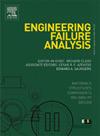润滑失效及辅助设备故障下曲柄连杆机构应力响应特性研究
IF 4.4
2区 工程技术
Q1 ENGINEERING, MECHANICAL
引用次数: 0
摘要
曲柄杆机构的动态特性对发动机的稳定性和使用寿命有重要影响。润滑失效和辅助设备故障可能引发曲柄连杆机构复杂的应力演化过程,进而影响系统的动态响应特性。针对这一问题,本文基于动力学理论和有限元法构建了润滑失效和附属设备失效的计算模型,并进行了失效状态下的应力响应分析。结果表明:在低速工况下,润滑失效引起的局部应力集中现象显著增加,而润滑失效引起的应力梯度随着转速的增加逐渐减缓,整体应力分布趋于均匀化;辅助设备故障引起的转矩扰动对曲轴整体应力分布影响较小,但在自由端局部区域引起较大的应力波动。研究结果可为曲柄连杆机构的健康监测、故障诊断和结构优化提供理论支持和工程指导。本文章由计算机程序翻译,如有差异,请以英文原文为准。
Research on the stress response characteristics of the crank-connecting rod mechanism under lubrication failure and auxiliary equipment malfunction
The dynamic behavior of crank-rod mechanisms has a significant impact on the stability and service life of engines. Lubrication failure and ancillary equipment failure may trigger a complex stress evolution process in the crank linkage, which in turn affects the dynamic response characteristics of the system. To address this issue, this paper constructs a computational model based on the kinetic theory and finite element method for lubrication failure and accessory equipment failure, and carries out the stress response analysis under the failure state. The results show that the local stress concentration phenomenon caused by lubrication failure increases significantly under low-speed conditions, while the stress gradient caused by lubrication failure slows down gradually with the increase of speed, and the overall stress distribution tends to be homogenized. The torque perturbation induced by the failure of ancillary equipment has less influence on the overall stress distribution of the crankshaft, but induces larger stress fluctuations in the local area of the free end. The research results can provide theoretical support and engineering guidance for the health monitoring, fault diagnosis, and structural optimization of the crank connecting rod mechanism.
求助全文
通过发布文献求助,成功后即可免费获取论文全文。
去求助
来源期刊

Engineering Failure Analysis
工程技术-材料科学:表征与测试
CiteScore
7.70
自引率
20.00%
发文量
956
审稿时长
47 days
期刊介绍:
Engineering Failure Analysis publishes research papers describing the analysis of engineering failures and related studies.
Papers relating to the structure, properties and behaviour of engineering materials are encouraged, particularly those which also involve the detailed application of materials parameters to problems in engineering structures, components and design. In addition to the area of materials engineering, the interacting fields of mechanical, manufacturing, aeronautical, civil, chemical, corrosion and design engineering are considered relevant. Activity should be directed at analysing engineering failures and carrying out research to help reduce the incidences of failures and to extend the operating horizons of engineering materials.
Emphasis is placed on the mechanical properties of materials and their behaviour when influenced by structure, process and environment. Metallic, polymeric, ceramic and natural materials are all included and the application of these materials to real engineering situations should be emphasised. The use of a case-study based approach is also encouraged.
Engineering Failure Analysis provides essential reference material and critical feedback into the design process thereby contributing to the prevention of engineering failures in the future. All submissions will be subject to peer review from leading experts in the field.
 求助内容:
求助内容: 应助结果提醒方式:
应助结果提醒方式:


